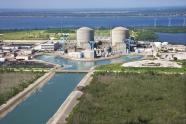Fueling the Nuclear Debate
What to do with radioactive materials

Nuclear energy may be jumping through a lot of hoops but finding the uranium to fuel those reactors is not one of them. That's a key finding coming from the Massachusetts Institute of Technology, which says that today's generation technologies will have a critical role in displacing carbon-intensive generation.
One of the concerns associated with increased nuclear development is that it would drive up the global demand for uranium and thus increase its price. But the MIT Energy Initiative that authored the report goes on to say that supplies are adequate, adding uranium is a relatively small component of the actual electricity generation. Therefore, if prices did rise exponentially, the added costs could be easily absorbed.
The scholars are sceptical, however, as to whether nuclear fuel can be recycled - as opposed to being used once and then buried. The report "strongly recommends" that the spent fuel be placed in "interim storage" for at least a century before it would be re-used in nascent "fast-breeder" reactors. That would allow the fuel to cool. It would also give researchers time to develop those advanced technologies so that they might one day become economically viable.
"Today, we would argue that we do not know whether spent fuel is a waste product or a resource," says Ernest Moniz, part of the MIT team that has written the report. Most of the world's nuclear facilities run on mined uranium that is enriched and which is used in "once-through" reactors. But a few of them are able to parse the uranium and the plutonium, allowing the uranium to be reprocessed.
The controversies surrounding both the burial of spent fuel as well as the recycling of the energy source have long hovered over the nuclear sector. Right now the used fuel is stored on site at nuclear facilities in concrete-encased steel caskets. That's where they will stay for a while as the current administration has shot down the hope of a permanent burial site at Yucca Mountain.
The issues with recycling are that the plutonium that is extracted from the uranium would proliferate and potentially be used as weapons' material by hostile nations. Think Iran and North Korea. The MIT folks envision a "breeder reactor" that would consume the fuel source at the same pace in which it is created, meaning no excess nuclear materials are produced. That idea, though, needs a lot of work, which is why the researchers say that nuclear is a good option but to stick with "once-through" technologies for now.
"We think nuclear power is economically
competitive" with coal power and one of the cheapest
options for utilities," says Charles Forsberg, MIT
research scientist in nuclear engineering and
executive director of the study. The availability of
uranium will not be a constraint to future growth,
the study concludes.
Uranium Resources
Globally, the International Atomic Energy Agency is predicting as many as 100 new reactors in 20 years with much of that construction occurring in the Far East and Russia. That is expected to cause the demand for uranium to rise 200 million pounds to 240 million pounds, annually. The agency says uranium resources are more than adequate to meet projected requirements.
Much of the uranium used in this country is now mined in Australia, Canada and Namibia while small amounts are derived in the western United States. About half the uranium used here, though, comes from accessing obsolete Russian nuclear missiles under a non-proliferation treaty called Megatons-to-Megawatts. That program will end in 2013 and therefore creates new pressure to get the fuel source from existing mines or through efficiency improvements.
With the future demand for nuclear power expected to increase, greater attention is now given to whether the used fuel should be buried or recycled. "Reprocessing" is now prevalent in France and Japan. Those countries have been able to separate the uranium and the plutonium from the rest of the nuclear waste, which has the potential to get 20-30 percent more use out of the uranium.
But that process was banned in the United States in the 1970s under President Jimmy Carter. That's because India had successfully tested a nuclear bomb and the president had feared that the extracted plutonium would be diverted for nefarious purposes. President Reagan lifted the moratorium, although the research into reprocessing still languishes.
Supporters of recycling say that the plutonium can be mixed with other elements that would essentially make the stuff non-weapons grade. They also say the fast-breeder reactors will consume the plutonium, making it a viable disposal method.
"It's real," says Clinton Bastin, a nuclear scientist who is retired from the U.S. Navy. "It's also essential for disposal of waste and an efficient use of nuclear materials."
Detractors disagree with that assertion. They add that the cost of researching and commercializing reactors that can recycle or reprocess spent fuel is expensive and risky.
That, too, is the conclusion of the MIT Energy Initiative. But those scholars are emphasizing that a build out should proceed based on today's "once-through" technologies, arguing that the nuclear plants will be cost-competitive while they serve to mitigate carbon emissions.
So what do you think? Please share your thoughts by
posting a quick comment below, or by sending a
longer reply to
energybizinsider@energycentral.com.
EnergyBiz Insider is nominated for Best Online Column by Media Industry News
Copyright © 1996-2010 by CyberTech, Inc. All rights reserved.
To subscribe or visit go to: http://www.energybiz.com